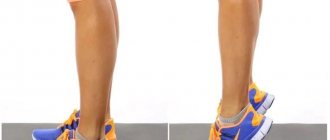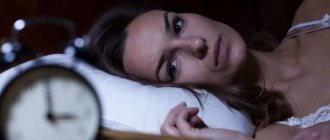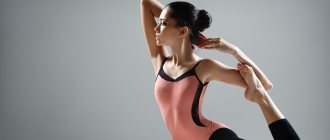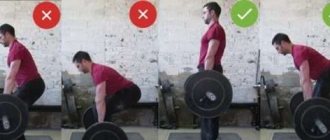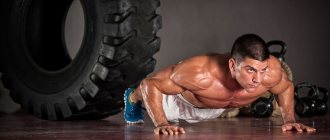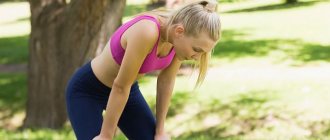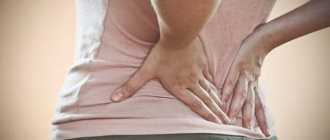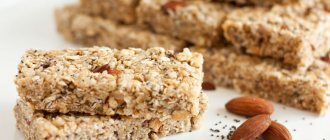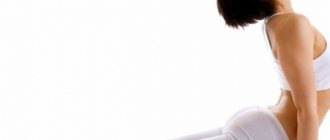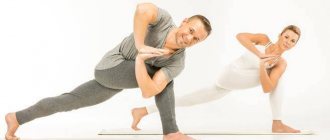Causes of pain
The causes of discomfort vary depending on your general health and level of physical fitness.
Sedentary work and a sedentary general lifestyle cause degradation of the back muscles.
https://www.youtube.com/watch?v=pm20aTWNvZM
In a normal physiological state, these are very strong muscles, capable of supporting not only body weight for a long time, but also additional dynamic and static forces that arise during labor or exercise. If muscles are not used taking into account their purpose, then the body considers them unnecessary, and the tissues gradually degrade. As a result, not only lower back pain, but also poor posture and other changes in the body.
Changes may also affect posture
With a sharp increase in loads, the muscles cannot cope with this mode of functioning, the tissues cannot withstand it, micro-tears and other mechanical damage appear. Lactic acid is a breakdown product in the muscles; it is always present in the tissues and is constantly excreted in the bloodstream.
Formation of lactic acid in muscles
But this only happens in two cases:
- muscles in their usual state. There are no overloads that cause microtrauma to tissues, causing a sharp increase in lactic acid and deterioration of blood flow. During ruptures, the ability of blood flow in the capillaries is disrupted, the intensity of lactic acid removal is further reduced, and its total amount increases;
Back muscles - trained muscles are subjected to excessive critical loads. Such lower back pain is felt by athletes who violate the recommended loads during training. The second reason is an incorrectly developed training plan.
Improperly organized training process can often result in injury.
Most of the acid is eliminated from the body within a short time after cessation of exercise, but this only happens in cases where the effort corresponds to the capabilities and training of the muscles. Lower back pain caused by lactic acid appears only during exercise; no discomfort is observed at rest.
Low back pain caused by lactic acid occurs only during exercise
Systematic and correctly scheduled training of the back muscles allows the body to quickly cope with the disposal of excess acid concentration, pain is significantly reduced and after 2-3 days disappears completely.
Prevention
In order to avoid back pain, the patient needs to perform the following simple steps:
- Maintain correct posture while walking and while sitting on a chair. In order to maintain it, you need to stand close to the wall and press the back of your head and heels against it. This position should be remembered and maintained in everyday life.
- If you need to stand for a long time, doctors advise changing your position every 10 minutes, transferring your body weight from one leg to the other.
- In cases where you need to sit for a long time, you need to relieve muscle fatigue. To do this, you need to bend your back, stretch your arms up and forward and breathe deeply. Next, you should stand on your toes, raise your arms up and stretch them well. These movements should be performed several times a day.
- It is recommended to hang for a long time on the horizontal bar.
- Watch what a person eats. It is necessary to exclude fatty foods. It is better to eat foods rich in fiber, vitamins and minerals.
- Dress appropriately for the weather and avoid drafts and hypothermia.
- Exercise every day.
- Don't lie in bed for a long time. Shorter rest periods will eliminate the likelihood of muscle atrophy.
Doctors advise performing the following simple exercise as a preventive measure:
- Lie on your back and press your buttocks to the floor.
- Raise your legs and bend them at right angles to the floor.
- Carefully move your legs to the right and left.
- During the exercise, a person should feel a feeling of stretching of the spine.
Another exercise involves a person lying on his back and raising his arms and legs high up. This position is held for several minutes, and then the person relaxes. We repeat the exercise several times.
The appearance of pain in the spine indicates that a person needs to consult a specialist. You should not endure the pain and think that it will go away on its own, and self-medicate at home. This can lead to a sharp deterioration in general health, rapid development of the disease and exacerbation of existing symptoms.
source
Where does the pain come from after training the next day?
Why do muscles hurt after training? Many people mistakenly believe that muscle pain is caused by a buildup of lactic acid, but this is not true. Muscle pain after physical activity, or delayed onset muscle soreness syndrome, occurs due to microscopic damage. Typically, pain appears after changing the training regimen, increasing physical activity and its intensity.
Severe post-workout pain occurs within 1 or 2 days and usually lasts 3 to 5 days. Of course, muscle pain can be mild - it all depends on the level of difficulty of your last workout.
Delayed muscle pain should not be confused with sharp and sharp pain during exercise - it can be a severe strain or sprain. This kind of pain will not go away on its own.
- Street workout for beginners: outdoor training
Localization of pain
Most often, pain in the back appears in a clearly defined location. It could be:
- The appearance of pain in the trapezius muscle. It is the most vulnerable because its fibers enter the shoulders and control their mobility. Usually, the largest and latissimus dorsi muscles hurt in artists and dancers, who often overstrain it. In addition, pain in this muscle can appear due to psycho-emotional problems.
- Pain in the trapezius muscle occurs even after eliminating the source of the disease and is accompanied by headache. This pain is characterized by the following symptoms: a person cannot move his head normally, pain spreads to the shoulders and cervical region. They are aching, constant in nature and most often can radiate to the shoulder region.
- The appearance of unpleasant sensations in the large rhomboid muscle of the back. With this pain, a person is unable to actively move his neck and shoulders. Pain in this area may occur due to the person not lifting heavy objects correctly. This occurs due to a shift in the location of the shoulder blades and the development of stoop in a person.
- If pain appears in the back muscles on the left, this indicates the development of osteochondrosis. The pain then becomes aching. When they occur, a person often feels dizzy, vision is impaired, and discomfort appears in the upper extremities.
- If the muscles on the back along the spine hurt, this indicates the development of a hernia and scoliosis. Painful sensations arise because the nerve roots are compressed, and parts of the spine change their usual position.
- The appearance of cervical osteochondrosis is characterized by compression of veins and arteries, pain appears in attacks. It is burning and pulsating. It is localized in the back of the head or on another part of the head. Symptoms of oxygen starvation occur: dizziness, nausea, migraine, vision drops sharply, sensitivity in the upper extremities and shoulder girdle decreases, shortness of breath occurs, and activity of the cervical spine decreases. If a person is in adulthood, he may suddenly lose consciousness, and if the disease has reached a chronic stage, then paresis and paralysis of the upper limbs appear.
- The appearance of thoracic osteochondrosis is characterized by the occurrence of acute pain with lumbago, gradually increasing. It is localized in the area between the ribs, in the shoulder blades and upper abdomen. The patient suffers from a cough, a lump in the throat, and difficulty swallowing. When bending over or lifting the upper limbs, the pressure increases and pain appears in the heart area.
- The appearance of lumbar osteochondrosis is characterized by the formation of pain in the lumbar region. It is sudden with lumbago. Muscles in the lower back and legs hurt. At the same time, it radiates to the groin and pelvis. If the vertebrae fuse, it may become smaller or disappear altogether. In this case, the patient experiences a feeling of numbness of the skin, paresis and paralysis of the upper limbs. Men have problems going to the toilet. In women, the menstrual cycle is disrupted.
- The appearance of pain in the back muscles on the right indicates the development of: osteochondrosis, radiculitis, scoliosis, intervertebral protrusions, tuberculosis and spinal injuries, muscle inflammation. If a patient has pain in the back muscles on the right side, this may indicate that diseases are developing in the body that disrupt the structure of internal organs. This indicates the development of: appendicitis, peritonitis, pyelonephritis, pancreatitis, pancreatic necrosis, duodenal ulcers, the appearance of kidney stones, cholecystitis, heart attack, angina pectoris, pneumonia, pleurisy. If unpleasant sensations appear in women, this indicates the development of adnexitis, endometritis, fibroids and cysts.
What muscles hurt after training?
Pain occurs in the muscles that were used during training. In the morning you will feel which muscles worked actively and which did not.
If you focused on the muscles of your legs and buttocks, then in the morning you will have pain in your legs. Usually the muscles on the front and back of the thigh and, of course, the gluteal muscles hurt.
If you've been doing push-ups or planking hard, you'll be wondering how to relieve post-workout pain in your biceps, anconeus, serratus anterior, triceps, and deltoids.
Usually the latissimus dorsi muscles hurt after planks, pumps, push-ups and exercises with dumbbells. Muscle pain after training in the back should go away within 2-3 days. If discomfort persists later, you should consult a doctor - you may have pulled a muscle.
If muscle pain after training is the norm, then pain in the joints is not at all. Be sure to consult your doctor. Possible causes of joint pain:
- various injuries - from bruises to dislocations or fractures;
- joint inflammation, or arthritis;
- joint deformation due to intense and regular physical activity.
To be sure that pathological back pain has appeared after training, you need to know its signs, and they are as follows:
- Begins to bother you immediately during training and doing exercises.
- The pain is acute.
- It radiates to the legs and buttocks.
- Doesn't stop after training.
- The next day the pain intensifies.
If your back hurts after training, it may be caused by excessive stress or exacerbation of spinal pathologies. Among these most often:
- Myositis.
- Intervertebral hernia.
- Displacement of intervertebral discs.
- Rachiocampsis.
- Weakness of the muscular-ligamentous apparatus.
What to do if pain occurs? The recommendations are as follows:
- Stop the activity.
- Take a position in which the pain is less bothersome.
- Apply a cold compress to the area of pain.
If your back muscles hurt after training, you should:
- Use external NSAIDs: Dolgit, Ketorol, Capsicam.
- You can take a course of painkillers and anti-inflammatory drugs: Diclofenac, Ibuprofen.
- Make a compress with Dimexide.
- Take a course of physiotherapeutic procedures: electrophoresis, magnetic therapy, laser treatment, mud applications.
You can use the services of a chiropractor.
At home, to get rid of back pain after exercise, you can use folk recipes:
- Grind the garlic, mix with heated pork fat and add eucalyptus leaves. Use to rub the painful area.
- Grate the horseradish root and mix with a small amount of sour cream. Apply on a napkin to your sore back.
If all the remedies used do not help, then a visit to the doctor cannot be avoided.
Signs of developing discomfort
Do your lower back muscles hurt after training, do you experience weakness, fatigue, a general feeling of malaise, or numbness? These are all serious symptoms to worry about. This condition may indicate problems with the bowels or bladder. In order not to bring the disease to a dangerous stage of development, it is important to promptly consult a doctor who will help prescribe effective treatment.
View gallery
Regular back pain in a child is also a serious cause for concern. Most often, this condition occurs in childhood due to wearing heavy things and problems with posture. But acute pain syndrome can also be a sign of a serious illness: scoliosis and even tumor formation.
How to get rid of pain after exercise
A simple life hack on how to relieve pain after a workout - do the workout again, but in a simplified version, so as not to harm yourself. Light physical exercise will make the blood circulate faster and help damaged muscles recover faster. Optimal physical activity is running, swimming or yoga.
2nd method: massage
Massage helps you relax and recover after a hard workout. It’s not for nothing that professional athletes go for massage sessions every week. You can make an appointment with a specialist or do the massage yourself using video tutorials.
Buy special clothing that will support your muscles and prevent them from overstraining during future workouts. Sports stores offer both compression tights and full sets of clothing.
A great tip for relieving post-workout pain is contrast water therapy. Fill the bath with warm water and use the shower to alternate between cold and warm streams.
What to do the next day after training and how to relieve pain? Do a gentle 10-minute stretch to help your muscles recover. If you don’t know how to relieve pain after training, prevent it! Be sure to warm up before strength training and stretch at the end of your workout.
Pain after training - what to do? Buy an inexpensive but effective ointment. Choose ointments or gels with added essential oils, such as arnica, camphor, menthol and peppermint. They cool muscles and relieve pain. There are a huge number of pain relief products on the market, and they all contain cooling ingredients. To suppress severe pain, choose products that contain painkillers:
- diclofenac;
- ketoprofen;
- ibuprofen.
In what cases should you go to the doctor?
Unfortunately, the appearance of discomfort during exercise may indicate problems in the body. The sooner proper treatment begins, the fewer negative consequences there are. When is it recommended to see a doctor?
- If pain appears during physical activity on the spine and remains intense for a long period of time even after it stops.
If your back hurts for a long time, you need to see a doctor - The pain is acute, impulsive, and not associated with movements. Continues the next day, the intensity fades very slowly.
Sharp acute pain is a reason to urgently visit a medical facility - The intensity of the pain increases over time and can be bothersome even at night.
If pain prevents you from sleeping, you need to start treatment as soon as possible.
Delay in seeing a doctor can cause very unpleasant consequences.
If your lower back hurts very often after playing sports, unfortunately, this indicates the presence of a disease. You should not delay your visit to the doctor, as complications may soon arise. It is imperative that you sign up for an examination if pain appears when there is a load on the spine and does not remain intense for a long period of time.
The same applies to athletes who suffer from acute, impulsive pain that is not related to mobility and exercise. With a high degree of probability, the pathology will be detected in a person whose pain intensifies every day.
The most common causes of back pain during exercise
Unfortunately, a lot of pain appears due to serious back diseases; physical activity only makes their clinical course more acute. The most common causes of back pain when exercising are considered to be:
- Myositis. Chronic or acute inflammation of muscle fibers, often found in people who do not exercise and lead a sedentary lifestyle.
Symptoms of back muscle myositis - Herniated intervertebral discs. During exercise, the pain is strong, sharp, and fades over a long period of time.
These are very serious disorders of the functionality of the spine. Physical stress can cause their partial displacement or destruction of the shell. It is strictly not recommended to engage in massages or other traditional methods of self-medication; consultation with a doctor is mandatory. Symptoms of lumbar disc herniation - Pinched nerve fibers. Incorrect position of the spine during physical activity can lead to pinched nerve fibers.
Pain of varying intensity appears, subsiding with rest. As a rule, complex treatment is prescribed: medication to relieve inflammation and physical therapy to restore the position of nerve fibers and strengthen the muscle tone of the back. Only strong muscles can guarantee that in the future the vertebrae will not shift and pinch the nerves. Nerve entrapment in the lumbar spine - Curvature of the spinal column. Physical activity is distributed unevenly; concentration points appear in some areas, which causes severe pain.
You need to know that curvature of the spine has a negative impact not only on the vertebrae, but also on all internal organs of a person. Description of pain in lumbar scoliosis - Stretching of muscle tissue. It is accompanied by severe pain; when stress is removed, the symptoms disappear in a short time.
Characteristic symptoms of a sprained back muscle
If, in addition to pain, a sharp limitation in the amplitude of movements and a deterioration in the general condition of the body is noticed, then you need to visit a nearby medical facility as soon as possible to make a diagnosis and select a treatment regimen.
- Why does my lower back hurt after exercise?
Treatment
To relieve the intensity of pain in the lower back after exercise, you should follow two recommendations: remove the cause and use painkillers. When it doesn’t help, you need to see a doctor.
As local therapy, it is recommended to treat the lumbar area with Dollit, Finalgon, Butadion and other ointments and gels of identical action.
"Finalgon"
The list of means is very wide, but in terms of effectiveness they are no different from each other. The existing difference in cost is explained by the popularity of the brands and the success of the manufacturers' advertising campaigns. Inflammatory processes in nerve fibers are treated with non-steroidal drugs.
Discomfort in the back
The back, including the spine, bears the brunt of the load during training. It is for this reason that you should not be very surprised at the occurrence of pain in this area. If unpleasant symptoms appear, it is important to immediately stop doing the plank and get proper rest. Continuing training is dangerous for the development of progressive back pain, as well as the appearance of diseases: kyphosis, scoliosis, hyperhidrosis.
Also, the back can be injured when performing a dynamic plank. Incorrect sudden movements, as well as poor technique, can cause damage to the vertebrae or problems with the nutrition of the intervertebral discs, which can have serious consequences for human health.
View gallery
Is it worth loading the spine if pain occurs?
The question is very individual, the answer depends on the type and intensity of pain. The only correct way of life is mandatory movement, and if possible, playing sports. This does not mean elite sport, when in order to win you have to cause serious harm to your health, including your spine. You need to do physical exercise to improve your health, you don’t need to set any records.
Sports exercises should be enjoyable and fatigue should be moderate.
Complete cessation of movement when pain occurs is recommended only in the acute period; in the future, taking into account the condition, motor movements of varying intensity can be started.
If your back pain is not acute, you shouldn’t stop moving.
Refusal of exercise has one goal - to eliminate the provoking factor of pain. Proper treatment will not only get rid of the pain that has arisen, but also prevent its occurrence in the future as much as possible.
Features of the exercises
When performing exercises to strengthen the muscular skeleton and spine, emphasis should be placed on the oblique, transverse, lumbar and rectus abdominis muscles, as well as the quadratus lumborum and paraspinal muscles of the back.
Many pain sensations can be eliminated using traditional treatment methods: proper rest, the use of cold and warm compresses, and taking medications. If the pain syndrome continues for several days, and the patient develops weakness and a feeling of malaise, then it is important to immediately see a doctor.
Some causes of back pain associated with the spine may go undetected for a long time. The attending physician will help you choose an effective method of treating the spine and eliminating pain.
Diseases for which it is prohibited to exercise in the gym
If an athlete constantly has lower back pain after visiting the gym, it is quite possible that he is suffering from some kind of disease. If symptoms of pathology are noticed, that is, the pain does not go away and radiates to other parts of the body and internal organs, you should urgently undergo an examination.
The disease is defined as a curvature of the spine. It should equate to at least 10% when measured using the Cobb method. In this condition, a person has a visible chest hump when bending forward at the waist. A professional is able to immediately identify this disease in a patient. Among adolescents aged 14 to 18 years, the prevalence of scoliosis is 3%. In adulthood, these figures increase to 20%. Both women and men are at risk.
With complications, the person begins to suffer from back pain, progression of scoliosis and psychosocial consequences. If scoliosis is advanced, pulmonary symptoms appear. Other diseases for which it is better to avoid playing sports include:
- diabetes;
- limb deformity;
- stomach diseases;
- chronic pathologies;
- disruption of the heart;
- brain concussion;
- functional disorders.
Choose among the best clinics based on reviews and the best price and make an appointment
Family Moscow, Orekhovy pr., 11, entrance from the yard (from the children's playground)
Shipilovskaya
7
- Consultation from 1850
- Reflexology from 2000
- Neurology from 500
Diagnosis of back diseases
To diagnose the condition of the spine, you should seek help from an orthopedic traumatologist or neurologist.
The specialist will carefully collect anamnesis, perform an external examination and a series of tests. If any pathology is suspected, additional examination will be required: magnetic resonance or computed tomography, laboratory tests, etc.
In our medical center you have the opportunity to undergo a comprehensive examination using modern expert-class equipment: a high-field magnetic resonance imaging scanner, a multifunctional ultrasound system, equipment for functional diagnostics and laboratory tests.
How to distinguish natural muscle pain from pathology
Physiological pain does not bother you at rest and goes away within two days
Exercise-related pain and muscle injury symptoms differ significantly in a number of characteristic features:
- Natural pain after exercise is associated with the accumulation of lactic acid in the muscles, while traumatic pain is caused by disruption of the fiber structure.
- Pain after exercise often appears the next day, while pathological discomfort appears immediately after the injury.
- The pain when the muscles are stressed is aching in nature, whereas with injury it is much more acute.
- Discomfort after exercise is noted in the area of stress, pain after injury spreads throughout the body.
- Pain syndrome of a natural nature is not observed at rest, while pain after an injury constantly makes itself felt.
- “Normal” muscle pain disappears after two days, traumatic pain persists and tends to intensify.
Most cases of pain and discomfort after intense training are associated with the lumbar spine. This is where the maximum weight and support load occurs, which immediately makes itself felt by unpleasant sensations. If pain occurs a few hours or the next day after exercise, there is no cause for concern.
It is important to pay special attention to the technique of performing exercises
Injuries to the lumbar muscles are of various types. This can be a serious lesion when the load during training was excessive. But more often we are talking about microtraumas caused by lifting a significant weight, a sharp bend or turn, a violation of the exercise technique on the simulator, or a significant load without preliminary warming up the muscles and warming up. In some cases, there is muscle spasm or pain in the intervertebral muscles, which are not ready to cope with the proposed load.
In most cases, lower back pain after exercise can be caused by doing the following exercises:
- deadlift with obvious violations of technique;
- squats with a heavy barbell;
- rod thrust with simultaneous body tilt;
- working on a rowing machine;
- hyperextension, or bending of the back with a fixed lumbar region.
Overview of Acceptable Sports
Even with a hernia caused by a barbell, you can choose an activity to your liking. Both girls and men can achieve sporting results. But before a new type of training, you need to consult with your doctor.
For patients with back and lower back pain, the following sports exercises are acceptable:
- Aerobics. Like exercise therapy, it improves blood circulation. Gives cardio exercise and the opportunity to lose weight.
- Yoga. Stretches the lumbar region. This will release the hernial protrusions and nerve roots from pinching. Good stretching will then be useful in iron sports.
- Run. Strengthens your back if you exercise with proper technique.
- Swimming. The best activity for a sore lower back. Relieves the spine, strengthens the spinal muscles. When swimming, there is no risk of new injury or deformation of an existing hernia.
- Martial arts. There is a high risk of injury here. But on the tatami or in the ring you can get all the stress the male body needs.
- Exercises on uneven bars and horizontal bars. They give you the opportunity to lose weight and gain muscle mass. The spinal column is stretched, which is useful for back problems.
The main causes of lower back pain after exercise
If your back hurts in the lumbar region after training, it is likely due to one of the following reasons:
- Inflammation of sensory and motor nerve roots. The disease is asymptomatic, but with intense movement it makes itself felt by severe pain. Additional factors that increase discomfort may be the initial stage of radiculoneuritis, osteochondrosis, poor posture or traumatic back injuries.
- Herniated intervertebral discs in the lumbar region. Weight bearing and sudden movements can put additional pressure on the discs, causing severe back pain.
- Osteoporosis or destruction of bone tissue due to a lack of calcium in the body. A popular cause of long-term lower back pain. An additional factor that also affects the level of back discomfort is spontaneous fractures of vertebral bodies or bone processes.
- Spinal injuries after a fall, as a result of which cracks or traces of fractures appeared in the vertebrae.
- Malignant tumors of the prostate or stomach. In some cases, they metastasize to the spine, which also causes noticeable discomfort after sports activity.
- Kidney disease - stones, pyelonephritis. If the lower back hurts after squats, and the patient has previously been diagnosed with diseases of the excretory system, it is worth undergoing a thorough diagnosis for the condition of the kidneys. Also among the possible causes is a mobile kidney. For those who have a slender build, this organ is not supported by adipose tissue, and there is a possibility of its twisting, which can cause not only severe pain, but also a sharp jump in blood pressure.
The frightening nature of some of these diseases is not a reason to panic. But if the pain syndrome makes itself felt too often, you should seek medical help to get diagnosed.
Degrees of muscle stretch
Sharp pain immediately after performing the exercise, which does not subside even at rest, is a dangerous sign. In such a condition, timely consultation with a doctor can be decisive, helping to maintain the functionality of the damaged organ or fragment of the spine.
The reasons for frequent injuries to the lumbar muscles, which most amateur and professional athletes experience, are hidden in the following factors:
- This area of the spine is subject to constant intense load - the weight of the person’s body, the weight of exercise equipment and additional load due to improperly performed exercises.
- Muscle weakness, especially when stretched. If the movements are within an acceptable range, and there is no signal from the brain about excess weight, cases of injury are practically excluded. However, if you put too much weight on a heated muscle, the risk of fiber tearing increases several times.
Another factor that determines frequent lower back injuries during sports activities is the redistribution of part of the load on small intervertebral muscles. Their structure is not designed to handle a significant load, so there is a high risk of injury. More often this happens when an athlete grossly violates the technique of performing an exercise - he moves too sharply or exceeds the weight limit.
Experts who develop effective training schemes recommend:
- be sure to warm up the muscles on which increased load is planned during classes;
- strictly monitor the technique of performing the exercise;
- gradually and step by step increase the load, listening to the recommendations of an experienced trainer and working under his supervision;
- drink a lot of clean water during training to remove excess lactic acid formed in the muscles through the kidneys;
- do not take increased weight until the body adapts to the current load.
Compliance with these simple requirements will help minimize the risk of injury and severe back pain.
Compliance with training rules
When conducting training, a person must follow the following rules:
- handle cargo and heavy objects carefully;
- regularly consult with a trainer (at least in the first 6 months of training in the gym);
- wear comfortable, loose clothing and shoes during training, which will help prevent the development of injuries;
- drawing up a proper diet with plenty of calcium in foods (it will help improve bones) and protein (it effectively affects weight and strengthens the muscle corset).
If back pain appears unexpectedly after working out in the gym, you should not panic too much. It is important to listen to the state of your body, reduce the physical stress on the body, which it cannot fully cope with at this stage.
If your lower back hurts after strength training, it is important to see a doctor immediately. It is dangerous to carry out self-treatment, since such a lesion in the back can be eliminated with the help of compresses and local medications, which would be very dangerous for other types of injuries.
